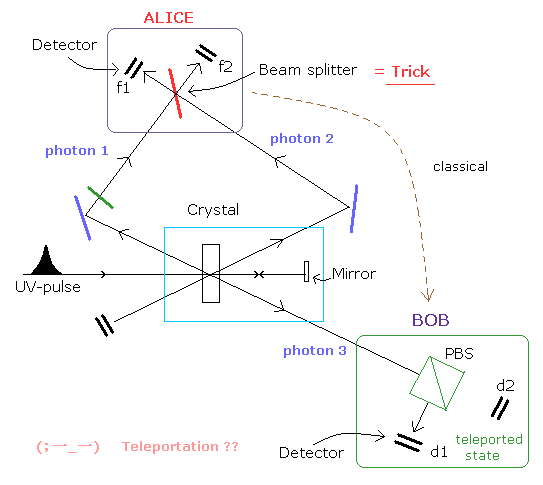
Top page ( correct Bohr model )
Electron spin is an illusion !
Trick of quantum teleportation. (14/8/28)
Teleportation often appears in fictional novels, and it means the transmission of objects over arbitrary distances.
In 1993, Bennett have suggested that the teleportation of the quantum states is possible. (Phys. Rev. Lett. 70, 1895 - 1899, 1993.)
And various experiments of the quantum teleportation have been reported since then.
But the quantum teleportation is really occurring ?
In this page, we show the quantum teleportation is only one of classical mechanical phenomena.
(Fig.1) Teleportation ?

In this experiment (Nature 390, 575-579 1997), they produced the entangled photons 2 and 3 by parametric down conversion.
In this technique, inside a nonlinear crystal, an incoming pump photon can decay spontaneously into two photons (2 and 3).
These photons are polarized orthogonally to each other. (horizontally (H) or vertically (V) polarized).
( But of course, photon point particle can NOT be polarized, so these photons are classical electromagnetic waves. )
We don't know which photon of 2 and 3 is horizontally (or vertically) polarized.
All that is known is that they are orthogonal to each other.
When we know that the two electromagnetic waves have the polarizations which are perpendicular (or any other definite angles ) to each other, these electromagnetic waves "automatically" become entangled photon pair !
So "mysterious" entanglement phenomenon can occur very easily according to the quantum mechanics.
For example, even when we oscillate two ion particles simultaneously, they become entanglement ion pair "automatically" as shown in this page.
But we should accept this "mysterious" entanglement states so easily ?
As shown this page, if we use the classical electromagnetic waves, these mysterious entanglement
states can be replaced by natural phenomena.
This means that the illusion of the entanglement is caused by the photons, which do not actually exist.
( If you check them, you will notice that these experiments often uses "photon", not electromagnetic wave. This is the trick of them. )
As I said above, the entanglement state of the photons 2 and 3 are produced in the EPR photon pair source.
Next we make the photon 1 and 2 entangled to each other by the beam splitter.
The UV-pulse is reflected by the mirror of the EPR source, and again passes through the crystal creating another pair of photons.
One of them will be prepared in the initial state of photon 1. (See Fig.1)
(Fig.2) Beam splitter (ALICE).
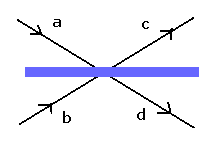
As shown in Fig.1, the photon 1 and 2 arrive at the beam splitter at ALICE from the opposite sides.
When the light is reflected from the splitter, the wave phase is reversed (= fixed egde ).
When the light passes through the splitter, the wave phase is not changed.
This experiment uses the destructive inteference of classical electromagnetic waves, as shown in Fig.3.
(Fig.3) Beam splitter (ALICE).
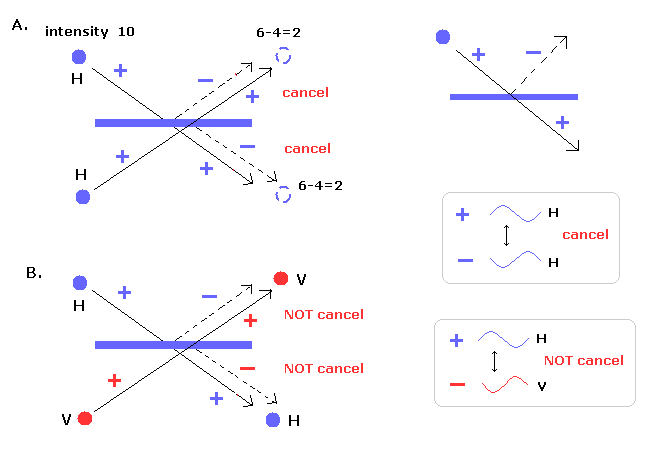
where horizontally ( H ) and vertically ( V ) polarized electromagnetic waves.
Suppose that the first intensities of the electromagnetic waves are "10", and the photon detector can detect it when their intensities are above some threshold (= 6).
So the intensity "10" means one photon, not two photons (=12).
And we suppose that the light intensities split into 6 and 4 (= pass and relfect ) at the splitter.
( When it is split into 5 and 5, both detectors detect no photon. )
When reflected, the light phase becomes reversed.
So if the two electromagnetic waves have the same polarization ( HH or VV ), they cancel each other and can not be detected as photons due to the destructive interference ( upper case of Fig.3 ).
And the lights of the different polarizations (H and V) don't interfere with each other.
So when the lights of 1 and 2 have the different polarizations, both of them can be detected as photons at the detectors.
And if detectors on both sides of the beam splitter fire simultaneously, it automatically becomes the Bell state, they insist.
Anyway, the results of this experiment can NOT be explained only by the particle nature of photons.
We have to use the wave nature (= interference and splitting ) of a single photon.
(Fig.3') Teleportation ??
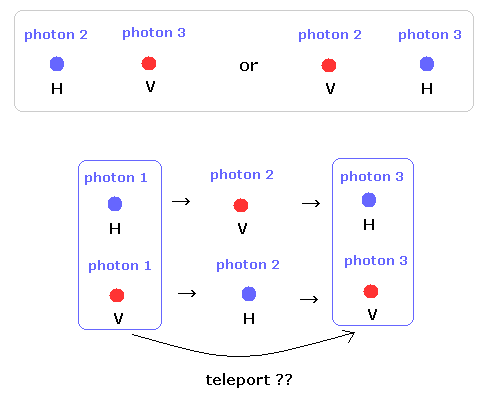
As I said above, the photon 2 and 3 have the polarizations which are perpendicular to each other ( H or V ).
And when detectors on both sides of the beam splitter fire simultaneously, the photon 1 and 2 have the polarizations which are perpendicular to each other due to the destructive interference of the same polarized lights.
So the instant we detect photons 1 and 2, it transforms the polarization of photon 3 into the photon 1 ( photon 1 = photon 3 ).
So they claim that they can achieve the teleportation. But is it really so ?
These results only mean that we manipulate the polarizations of them, and make the photons 1 and 3 the same polarization state.
So we can explain these results from the classical-mechanical viewpoint simply.
( We need NOT use the "mysterious" quantum teleportation. )
(Fig.4) Teleportation ?
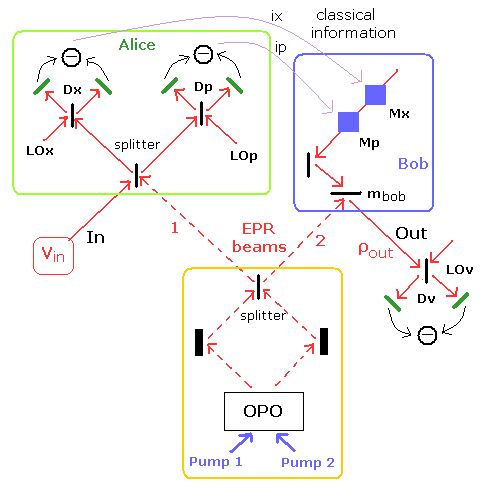
In the above section, they use the horizontally and vertically polarized photons as a entanglement state.
In this section (Science 282, 706, 1998), we take electromagnetic waves of the quadrature phase as a entanglement state.
(So their polarizations are the same.)
(Fig.5) Entangled two electromagnetic waves ( α1 and α2 ).
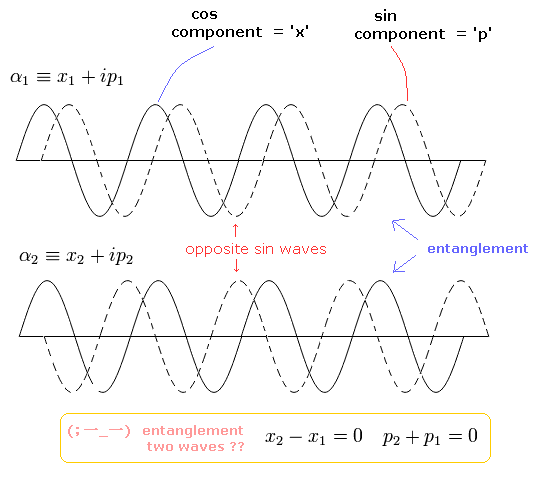
Each wave (= photon ) can be expressed by the superposition of the cosine (= x ) and sine (= p ) waves, as shown in Fig.5.
In Fig.5, the cosine components of α1 and α2 are the same phase. ( x1 - x2 = 0. )
And the sine components of α1 and α2 are the opposite phase. ( p1 + p2 = 0. )
Here we use these α1 and α2 photons as a entangled photon pair.
(As I said, the quantum mechanics likes to use the word "entanglement" in various situations.)
And from Fig.5, it is very difficult to imagine the particle nature of the photon.
If we consider the photon as the sum of the classical electromagnetic waves, we can easily accept the states of Fig.5.
Lasers emit artificial light of the same phase (= coherent light), which is called "stimulated emission".
Of course, to get these same phase light, we have to use many electrons moving simultaneously, which means that only single photon can NOT be these coherent lights.
But the quantum mechanics likes to link the same phase light to the single photon.
So this preconceived idea causes the illusion such as " Schroedinger's cats ", which is explained in the latter parts.
On the other hand, in the spontaneous emission, various phase lights are mixed, so the same phase light is a very artificial thing.
(Fig.6) Oscillating electrons emit electromagnetic waves.
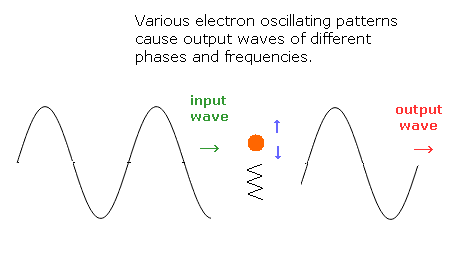
First, we try to emit the lights which frequency is twice the input lights.
When the input light is strong, the oscillating electrons often reach their maximum points.
At the maximum point, the electrons stop, so their movements become irregular.
So the emitted electromagnetic waves by these irregular electrons also becomes irregular.
And in them, the electromagnetic waves of two times frequency (= 2f ) is included.
This waves is increased by interference between the reflecting mirros.
Next we input both the original (= frequency of f ) and the 2f light ( Pump light ) into the oscillating electrons.
These two kinds of lights interfere with each other, so they oscillate the electrons at the frequency of f.
This causes another photon of frequency f.
As a result, we can get the two photons (= electromagnetic waves) of the same phase and frequency (= f ).
These same phase photons are called " squeezed light ".
(This place corresponds to a subthreshold optical parametric oscillator ( OPO ) of Fig.4.)
From this emission mechanism, the particle nature of the photon can not be imagined at all.
Next we try to generate two electromagnetic waves of the "opposite" sine components. (See Fig.5.)
To generate these waves, we get two squeezed lights (the sum of them is 4 photons) into the half beam splitter. (Fig.7.)
The difference between these two squeezed light phases are 1/4 (which means one becomes cosine, another becomes sine waves).
These phases can be adjusted on their ways.
(Fig.7) Reversing only the sine component.
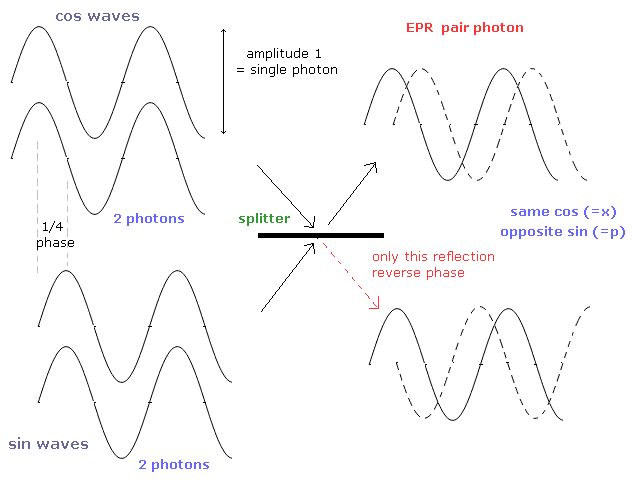
At this splitter, when the light gets in only from the lower side, the wave phase is reversed by the reflection.
So we can get the two entangled photons of α1 and α2 of Fig.5.
Here we express the cosine component wave as x, and the sine component as p, as follows.
(Eq.1)

which satisfies
(Eq.2)

According to the uncertainty principle, we can not know the two values (x and p) of one particle at the same time.
But we can know the two values ( such as Eq.2 ) of the two particles, keeping the superpostion states.
And we prepare another unknown input wave ( Vin ) of
(Eq.3)

where xin and pin are unknown values.
These two waves of Vin and α1 get into the spilitter at Alice of Fig.4.
And only one reflection of them reverses the wave phase.
These mixed electromagnetic waves arrive at the two homodyne detectors Dx and Dp at Alice of Fig.4.
For example, at Dx, the local oscillator light (= LOx) interferes only with the cosine component of the mixed waves of Vin and α1, and increases and measures only the cosine component of them.
So at Dx and Dp detectors, we can get the two informations (= ix and ip ) of
(Eq.4)

Due to the reversed phase at the splitter, one is addition, and another is subtraction, as shown in Eq.4.
As I said above, we can know the two informations of the two particles due to the uncertatinty principle.
And according to the quantum mechanics, these two particles of two known informations are in the entanglement state. (This is called " Bell-state measurement ". )
The informations of ix and ip are transimitted in the classical way to Bob as shown in Fig.4.
The amplitude and phase modulators ( Mx and Mp ) transform the photocurrents (ix and ip) into a complex field amplitude, which is then combined with the EPR beam α2 at the mirror mbob.
In this manner, the α2 changes as
(Eq.5)

where g describes Bob's suitably normalized gain for the transformation from the photocurrent to output field.
At Bob site, we adjust g value based on the informations of ix and ip.
When we make this g value close to 1, the state of Vin is "teleported" into the output (= ρout) like
(Eq.6)

Substituting Eq.2 and g=1 into Eq.5, we can get the result of Eq.6.
And when the fidelity of
(Eq.7)

is over 0.5, the quantum teleportation is achieved according to their claim.
But from the classical viewpoint, these results are NOT surprising.
Why can we claim these results are "mysterious" quantum teleportation ?
According to the quantum mechanics, all these states are superpositions, which are many-world like.
So these results seem to be important from the quantum mechanical viewpoint.
But from the classical viewpoint, these results are NOT surprising. (These are very "natural" things.)
( How do you think about it ? )
According to the quantum-mechanical superposition, a cat can be dead and alive at the same time in a box. (= Schrodinger's cat. )
But as the quantum mechanics says, Schrodinger's cat states are really existing ?
As I said above, to get the same phase and steady coherent lights, we need to input strong laser enough to oscillate many electrons simultaneously, which then emit the same phase electromagnetic waves.
(Fig.8) Same phase coherent light.
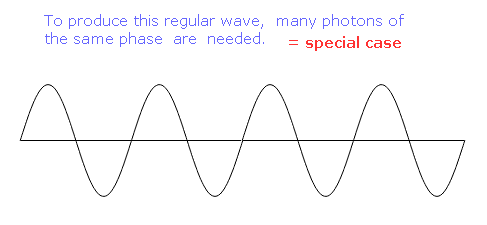
So the coherent light includes many photons, which can be expressed as
(Eq.8)

In Eq.8, n means the photon number which satisfies Poisson distribution.
Poisson distributed photon number means the photons are moving independently from each other.
So they claim that the same phase coherent light is very "natural" state and is one of classical-mechanical waves.
But this explanation is very strange.
As I explained before, the spontaneous emittion causes various phase electromagnetic waves.
So the same phase coherent light is a very "artificial" thing.
It is natural that the electromagnetic wave phases are different from each other and they are mixed.
( As you know, the classical waves can overlap with other classical waves from the classical viewpoint ! )
The quantum mechanical physicists claim that a single photon is in Schrodinger's cat state.
Because when we measure the wave phase of the single photon using LOx or LOp lights, its phase can not be determined like Fig.9.
(Fig.9) Single photon = Schrodinger's cat ??
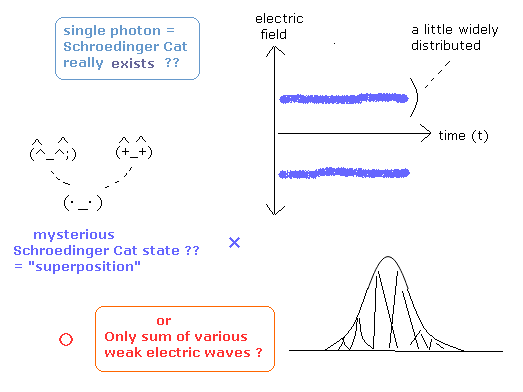
As shown in Fig.9, the electric field of a single photon doesn't become sine or cosine curve.
(But this state is natural, I think. The same-phase coherent light is more "special" and artificial. )
So they insist that the single photon is a many-world like state (= Schrodinger's cat ), which is a "superposition" of many photons of various phases.
But is it really so ?
The quantum mechanical physicists like to use the many-world like "superposition" in various situations.
By the way, how can we get the single photon of Fig.9 state ?
Like above case, the squeezed light (which includes two photons according to the quantum mechanics) is produced by the optical parametric oscillator.
But in this case, we have to make the squeezed level very low.
This means this device hardly emit the squeezed light (= 2 photons ). It emits the light "occasionally".
And we get this weak squeezed light into the beam splitter, at which the probability of photon passing the splitter is very low (= only several percents).
So when we detect a single photon at the pass-side detector, we can get another single photon at the reflection side, too
(Of course, this explanation is based on the quantum-mechanics.)
And we can not know when the squeezed light would be emitted without the pass-side detector.
So this phenomenon is random and occasional.
From the classical viewpoint, due to the very weak input waves, they can oscillate some of the electrons weakly and randomly.
(To make many electrons oscillate simultaneously and regularly, we need strong input waves.)
And some of them occasionally emit the weak electromagnetic waves above the detection threshold, which is almost reflected by the splitter.
And the intensities of these emitted weak electromagnetics are changing randomly from 0 to 2.9 photon detection threshold.
As a result, it is very natural that these wave phases are random.
So we can not claim that this single photon state is Schrodinger's cat state only in this experiment.
( How do you think about it ?)
For example, we take the single "classical" wave packet of Fig.10
(Fig.10) One example of a single "classical" wave packet
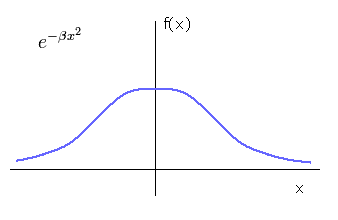
The Fourier series expansion of Fig.10 function is
(Eq.9)

As shown in Eq.9, even a single classical wave packet contains many waves of the various wavelengths.
(But we need NOT use the word of "superposition" in this state.)
So the result of Fig.9 is very natural from the classical viewpoint.
Actually, when we try to teleport these Schrodinger's cat state, we have to use a time-resolved apparatus that deconstructs the input wave packets into a stream of infinitely small time bins and reconstructs them at the outputs.
Because the input wave has a wide frequency bandwidth.
(Of course, when we weaken single-pulsed laser beam by the filter, we may get one single-phased photon (= wave ). But the above method is different from this.)
Wigner distribution function is routinely used in this area.
And its negative values are said to express non-classical waves.
But is it really so ?
Wigner function is
(Eq.10)

The Schrodinger cat (= superposition ) state is expressed as
(Eq.11)

So the density operator of Eq.11 becomes
(Eq.12)

Eq.12 contain the negative term, so the physicists claim this is nonclassical.
They say the classical density matrix is
(Eq.13)

But as I said above, the mysterious superposition state can be explained by the classical state in which many weak electromagnetic waves overlap with each other.
So if we don't consider the quantum mechanics, we need not use the strange phenomenon like Schrodinger's cat.
Schrodinger himself doubted the quantum mechanical superposition state, so he made the example of famous Schrodinger's cat.
(This case is similar to that of Pauli who doubted the existence of "spin".)

2011/4/27 updated. Feel free to link to this site.